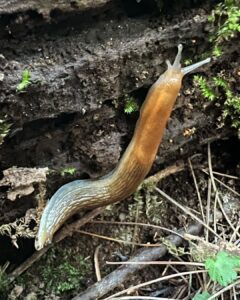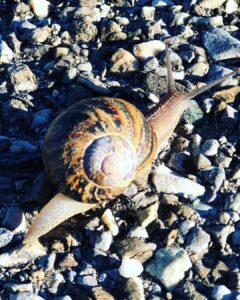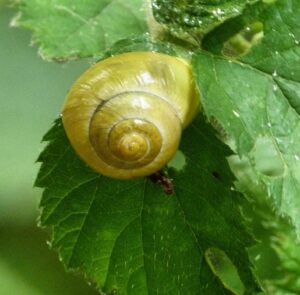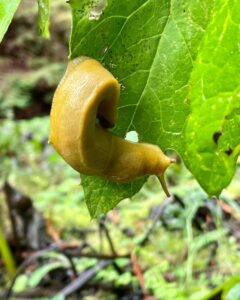Both snails and slugs look very similar, with the leopard slug being the most common species in North America. People have acknowledged the similarities between snails and slugs for centuries, but they are two completely different animals despite their similarities.
Some animals look very similar and even seem to be related. The slug and snail families are no exception. They both look and behave similarly, but there are some physical differences, so you should keep an eye out for these animals when you’re out in your garden.
Have you ever wondered what the difference between a slug and a snail is? It sounds like a simple question, but it can be difficult to explain because they are both slimy and very similar in appearance and behavior.
So when you look at them, they seem identical. But once you learn the answers to these questions, you’ll be able to answer whether slugs or snails are better for your garden. So, if you are wondering what the differences between a snail and a slug are, read on.
What is a slug
A slug is a common name for one of the most widespread invertebrates in the world, the gastropod mollusk. In fact, there are around 22,000 species of gastropods. Slugs are easy to spot; they look like little worms with long, slimy bodies that are usually hidden under leaves and debris.
Slugs are a type of invertebrate that eat plants. They can be large or small, but most land slugs are about 3 inches long. They’re noted for their slimy appearance and slow speed. Slugs can be found in damp, dark places like mud puddles and gardens.
Slugs are usually nocturnal, hiding in damp places such as gardens or fields during the day. Most slugs are herbivores, eating plants such as grasses and vegetables. However, some species are omnivores that eat both plants and animals. They eat plants and other animals like worms. They also feed on algae that grow on plant leaves and stems.

Slugs reproduce by releasing eggs into the soil, where they will hatch into tiny babies. If you find slugs in your lawn, it’s likely because you’ve planted something that attracts them.
In terms of damage to crops, the Spanish slug is considered more destructive than other slugs because it eats both plants and mushrooms, as well as being able to eat other slugs.
What are snails
Snails are a type of gastropod mollusk. They have a shell composed of calcium carbonate, and they move by means of internal muscles. The name comes from the Greek word “snaillos.” Snails can be found almost anywhere in the world.
They have a coiled shell made up of many hard layers that protect their body. It also has a two-part foot called the radula, which it uses to scrape algae from rocks and shells. They also make their homes in damp soil, rocks, logs, or leaf litter.
Snails move by contracting muscles in their foot and pulling forward using a muscular foot attached to the shell. Most snails are herbivores; they eat plants or algae to survive. Some species are carnivores that eat other animals, such as fish or amphibians; others feed on dead organic matter, such as rotting leaves or animal droppings (feces).

They move slowly and can be found on land or in water. Snails are native to most parts of the world but are not common in some regions because they are considered pests. A snail’s shell protects snails from predators and prevents dehydration by regulating its body temperature.
Differences between Slugs And Snails
A snail is one of the most common animals in the world, but it’s also one of the smallest. Snails can grow up to two to 5 long and are often red or brown. They have a shell that protects them from predators, but they also use it to filter out bacteria from their environment.
The major difference between a slug and a snail is the presence of a shell; snails have a hard spiral shell, while slugs have a mantle.

- Snails have shells, while slugs do not.
- Snail shells are cones or rounds, while slugs have longer bodies.
- Snails can store calcium in their shells; slugs cannot.
- Snails protect themselves from predators using their shells by herbinating into them. Slugs have no shell but curl up into a ball or release more mucus.
- Slugs also tend to be more colorful than snails.
- Snails are taller and fatter than slugs.
- During the freezing months, slugs burrow into the ground to survive while snails hibernate in their shells.
- Slugs have an outer skin that protects them from predators, while snails have shells for this purpose.
- Snails move more slowly than slugs.
Similarities between snail and slug
Snails and slugs are both invertebrates, which are animals without backbones. Slugs can be further differentiated from other mollusks by their lack of an external shell.
They also have a distinctive body shape, with a long body, which is usually more or less cylindrical. Below are the various similarities between slugs and snail
- Snails and slugs are gastropods, meaning they’re mollusks and have soft bodies.
- They both live in wet, damp, and moist places; the reason they come out after it rains.
- The snails and slugs also have two pairs of antennae that are used for sensing their surroundings.
- Both animals are carnivores, omnivorous, detritivorous, and herbivorous
- Slugs and snails have mucus that aids their movement.
- They both have tentacles for sensing.
- Slugs and snails have redula for scrapping up food.
- Snails and slugs are both very slow-moving creatures that use camouflage to hide from predators such as birds or other animals.
- They both move by muscling through the soil, using their bodies to push themselves forward.
- Snails and slugs are hermaphrodites; they have both male and female reproductive organs.
Can slugs and snails mate
Slugs and snails are all hermaphrodites and can fertilize themselves, but they can mate, too. By releasing pheromones into their slime, slugs indicate a readiness to mate, and some make quite a spectacle.
Snails and slugs are part of the same family, so they share a lot of commonalities. But they also have some differences. However, the mating process is similar for snails and slugs: they will mate by having sex when the opposite sex indicates its readiness. However, slugs and snails can’t cross-breed.
This can be done using one of their tentacles or using the male’s antennae to penetrate the female’s body cavity. After mating, the female will lay her eggs in a safe place to develop into new snails or slugs without being eaten by predators or other animals.
Slugs and snails have both male and female reproductive organs. They are hermaphrodites, meaning they can fertilize themselves without having sex with another animal.
Is Having Slugs and Snails In Your Garden Good or Bad?
There’s no doubt that Slugs and snails are certainly a nuisance in the garden when left uncontrolled. They can be quite a pain to get rid of and even damage your plants if you don’t catch them in time.
These pests like to come out at night, so they can eat anything they find. They are also known to eat plants and flowers, which can cause damage to your garden.
But it’s important to understand how they affect your plants and how you can keep them from eating all of your favorite vegetables. But do slugs and snails belong in your garden? According to a recent study, the answer is mostly bad.
The study, published in the journal Biology Letters, looked at the effect of slug and snail populations on plant growth. The researchers found that when there are large numbers of slugs or snails in an area, it causes several negative effects on plants. These include:
- Decreased photosynthesis (the process by which plants convert sunlight into energy)
- Decreased nitrogen uptake by plants (which helps them survive)
- Increased disease susceptibility to plants
- Reduced healthiness of plants
Slugs and snails love moist, cool places like gardens and flowerbeds. They can be attracted to your garden by the smell of plants or water. These pests will also eat dead leaves and other plant parts, so they are not just pests—they can also cause plant damage by eating leaves. They eat things you care for, like seedlings, tender shoots, and newly-planted seeds.
Also, slugs can help control plant-eating insects like aphids. Aphids are tiny insects that feed on plants and can cause damage if left unchecked. If you have slugs in your garden, they will eat the aphids, keeping them away from your plant.
Although slugs benefit some gardeners, they can cause problems for other gardeners when their population is high by damaging their plants or causing them to lose their leaves. In addition, slugs can spread disease from one plant to another by feeding on the roots of infected plants.
What attracts slugs and sail to your garden
There are many reasons slugs and snails are attracted to your garden. Slugs and snails are attracted to your garden because of the food they can eat.
They are also attracted to your garden because of the moisture that can be found in the soil and the nutrients that plants provide. Also, slugs and snails are attracted to your plants’ color, texture, and odor.
They feed on plant leaves and are drawn to the moist soil that comes with rainfall. They also like to travel through leaf litter or wet soil. So a lot of moisture in your garden will attract them.
They want to find enough food and water and avoid predators or other threats. In other words, they want the same things as you do; but on the other side of the fence. You can also reduce the amount of moisture in your garden by watering it well.
In addition, these pests are attracted to your garden because it provides shelter from predators. Slugs can’t move very quickly, are generally sluggish, and need somewhere safe to hide from predators, such as under leaves and plants during the day.

Are garden snails harmful to humans?
Garden snails, also known as land and common snails, are usually not harmful to humans. However, if you come in contact with them, it is important to wash your hands immediately and avoid touching open wounds or broken skin. Contact with garden snails can also cause irritation or allergic reactions in some people.
Snails are a vital part of the ecosystem because they eat pests such as aphids and other small animals, helping to keep your garden healthy and pest-free. They also help control pests like insects that infest your plants or attack your lawn if left unchecked.
Garden snails are incredibly common and easy to find in most gardens. Garden snails are pretty harmless. They’re not poisonous or harmful in any way—they just eat plants. Therefore destroying your garden.
These snails are voracious eaters and will consume just about anything you put out for them to eat, including fruits, vegetables, flowers, leaves, and other garden plants.
Because of this tendency to eat whatever is available in the environment around them and the fact that they have few natural predators (other than humans), they can be very destructive in gardens where food is plentiful.
Can a slug become a snail?
No, a slug can’t become a snail. Slugs are snails’ closest kin but are not the same thing. Without a shell, even a snail cannot survive; without a shell, a slug cannot become a snail. Slugs are mollusks that belong to the phylum Mollusca.
They have soft bodies covered in slime and lack specialized internal organs. Slugs are herbivores and eat plants, algae, fungi, and other small animals. Snails and slugs look similar but differ in biology, behavior, and appearance.
There are many differences between these two species of mollusk. For example, snails have shells made up of calcium carbonate that helps protect them from predators like birds, fish, and other snail-eating creatures. Slugs do not have shells; they rely on their thick skin for protection.
Slugs have no shells or exoskeletons like snails, but they have an integumentary covering that protects them from predators. The integumentary covering also helps protect their bodies from bacteria and other microscopic organisms that try to feed on them by getting into their bodies.

Slug vs. snail speed
A slug is a type of snail that moves slowly, whereas a snail moves quickly. The word “slug” is thought to have originated from the name of the common earthworm, which has been called “sluggish” or “slow-moving.” It’s also thought that slugs are part of a larger group of mollusks called Planorbidae or land snails.
The speed at which slugs and snails move depends on their size and how much they weigh. A small slug can reach speeds up to 5 centimeters per minute (about 2 inches per minute).
A large snail can reach speeds up to 15 centimeters per minute (about 6 inches per minute). The smaller the slug or snail, the faster it may move; however, bigger snails tend to move more slowly than smaller ones.
The speed of a snail or slug will vary depending on the environment in which it is moving. If a slug is moving through a thick forest with many obstacles, it will move at a slower pace than if it were moving through a field where nothing was in its way.
Are snails born with shells?
Yes, snails are born with shells. They hatch from eggs that have already developed their shells. Snails can live for several years and grow to be quite large. Snails are invertebrates and have a hard exoskeleton, which is the outer shell of their body.
The mollusks that make up this group are mostly bivalves (seafood), gastropods (such as slugs and snails), and cephalopods (octopuses).
The earliest fossils of bivalves date back to the Cambrian period, some 505 million years ago. Invertebrate animals like snails get their hard outer shells in the same way as bivalves: by building them from calcium carbonate.
Each snail’s shell is made up of layers of calcium carbonate that are secreted by the animal’s body. When a snail molts, it sheds its old shell and grows a new one. Snails can grow several new shells during their lifetime; however, only one will ever be fully grown before molting again.
Slug and snail killer
There are various ways to get rid of slugs and keep them away from your garden. However, there are faster ways to eliminate these pests, which involve using proven, ready-made killers. Some of the best slugs and snails include:
Monterey Sluggo Max3 Jug Iron Phosphate
The Monterey Sluggo Max3 Jug Iron Phosphate is an excellent choice for killing slugs and snails. It’s a powder, so you don’t need to mix it with water or anything; shake it in the jug and pour it into the top of your outdoor garden.

This product has been tested by Pest Control Experts and is 100% effective against slugs, snails, and other pests. It’s also safe around children and pets, so you can feel good about using it around your family.
Bonide Diatomaceous Earth
Diatomaceous earth is a natural substance that kills slugs and snails. It is made up of fossilized diatoms. Diatomaceous earth works by dehydrating the slug or snail’s exoskeleton. In addition to killing slugs and snails, it also works as a general insecticide.

This product is a non-toxic and organic way to kill slugs, snails, and earwigs. It works by dissolving in water and then dehydrating the pests. The results are rapid and effective.
Exterminators Choice Slug and Snail Spray
Exterminator’s Choice Slug and Snail Spray is a unique solution to your slug and snail problems. This product uses the power of natural ingredients to keep your yard free of unwanted bugs and pests. It’s safe for all lawns, including those with pets or children, and it’s completely non-toxic.

Exterminators Choice Slug and Snail Spray is an easy to use; spray on your plants, shrubs, flowers, trees, and fruit, and it will instantly kill slugs and snails!
The Exterminator’s Choice Slug and Snail Spray is a great way to eliminate slugs and snails in your yard. It’s made with natural ingredients, so it won’t harm the environment. The spray works on all slugs and snails—including fireworms and carrion worms, and can be used on lawns, gardens, flower beds, and more!
Corry’s Slug & Snail Killer
Corry’s is a natural organic product that dehydrates the slug or snail and kills it through its natural defenses. The solution is made from organic ingredients, so it won’t harm your plants or pets—which can be a concern with other products on the market. It’s available in both ready-to-use and concentrated forms.

Corry’s Slug & Snail Killer is a natural, biodegradable, safe product for the environment and people. It’s made from corn and soybeans, so it’s completely plant-based and kills slugs and snails naturally. The best part? It doesn’t have to be reapplied once a year!
It attracts slugs and snails like a magnet, slowly killing them over time. That means you can do your business without worrying about being overrun by pests. Remains effective after rain
Safer Brand Slug & Snail Killer
It works on contact by penetrating the slug’s skin and causing it to die within seconds. You can use it anywhere in your garden—on plants, shrubs, or even trees. You can use it as often as you like. The only limit is how quickly you want to kill the pests.

This product kills slugs, snails, and other garden pests by reducing their slime trail. It acts as a contact poison to the slug’s waxy outer layer found on its back.
Once it comes into contact with water, it starts to dissolve and releases a highly toxic dinitrophenol compound that is absorbed into the slug’s body through its mouth. This chemical causes them to die within 24 hours of contact.
It’s easy to use; sprinkle the product around your plants where slugs and snails love to hide; they can’t resist the taste of this amazing product.
Bonide Garden Naturals Bug and Slug Killer Bait
Bonide Garden Naturals Bug and Slug Killer Bait is an insecticide or pesticide that kills slugs and snails by disrupting the nerve impulses they use to control their muscles. This highly effective organic pesticide can be used around your home or garden. It’s safe for pets, children, and wildlife.
Bonide Garden Naturals Bug and Slug Killer Bait is a great way to manage pests in your yard. This liquid solution contains a powerful blend of natural ingredients that kills slugs and snails on contact.
The liquid formula is easy to apply and won’t damage plants or cause damage to your garden tools. You’ll have peace of mind knowing your yard is safer than ever!

